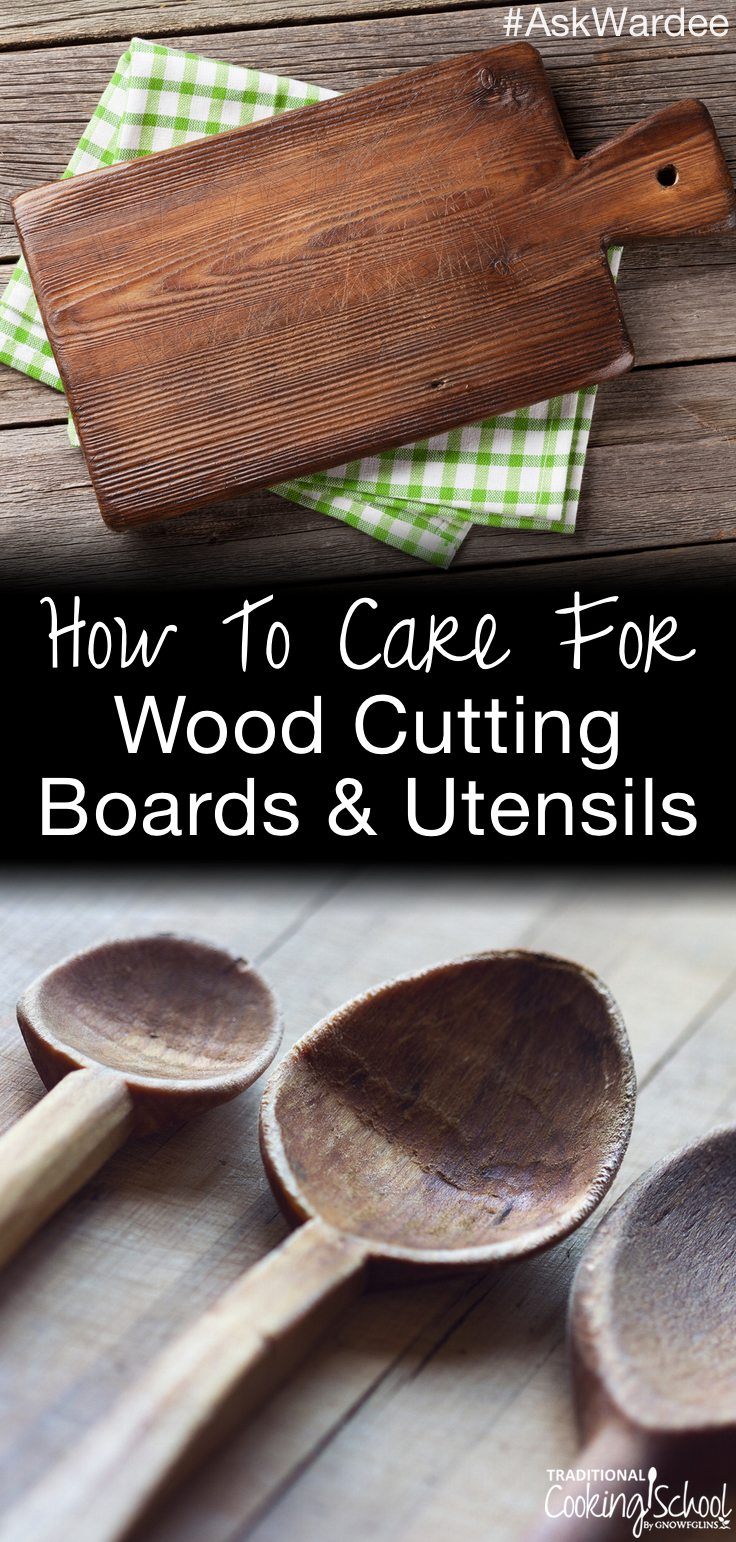
There’s just something about wood cutting boards and spoons that conjures up feelings of rustic tradition and simple living, isn’t there?
Properly cared for, wooden kitchen tools can last many years — long enough even to pass down to your children and grandchildren as family heirlooms.
Yet many people mention using mineral oil and beeswax for this task…
Is this the best or safest choice?
“What is the best way to maintain wood cutting boards and utensils?” Robin S. asks.
Robin wants to keep her wood utensils in beautiful condition — without her food coming into contact with harmful chemicals and by-products.
And I bet you do, too!
So, I’m going to show you how to care for them on today’s #AskWardee. It’s easy and healthy.
I broadcast #AskWardee live each Wednesday at 10am Pacific (1pm Eastern) on Periscope and Facebook Live. Both the podcast and video replay of this week’s show are below. Enjoy!
Subscribe to #AskWardee on iTunes, Stitcher, YouTube, or the Podcasts app.
The Question: How To Care For Wood Cutting Boards
Robin S. asks:
What is the best way to maintain wooden cutting boards and utensils? I want something that doesn’t go rancid, and I’ve read about a mineral oil and beeswax combination, but I’m not familiar with mineral oil. What does the term ‘mineral’ mean? What exactly is it? Is it non-toxic? Is it truly food-safe? Are there organic and conventional varieties? I like to know all the details about something before I use it, but I feel like I’m in over my head. What do you use to maintain your wooden cutting boards and utensils? Thanks so much!
My Answer:
First, let’s talk about safety. Since it often comes up: is wood a safe, sterile choice?
Actually, yes. In fact, a study at U.C. Davis suggests:
…[F]ood can be prepared safely on wooden cutting surfaces and that plastic cutting surfaces present some disadvantages…
The whole study is fascinating! I found it notable that they discovered disease bacteria were not recovered from new wooden surfaces in a short time after they were applied. New plastic surfaces allowed the bacteria to persist (though could be easily cleaned). The big difference came in when comparing old wood and old plastic. The old wood acted like new wood, while old plastic surfaces that were knife-scared were impossible to clean and disinfect manually.
Thus… wood can provide a safe surface to prepare food, whether it’s new or old!
What is the best way to maintain wood cutting boards, though — and how often?
How To Clean Wood Cutting Boards & Utensils
With proper care, wood cutting boards and utensils can last many, many years — while plastics get worn out and must be tossed. So it’s not just beauty that reigns here — wood is more frugal and functional as well. 🙂
To clean after most uses, scrub with hot water and soap, then air dry or towel dry.
If preparing raw meat, however, clean afterward by dousing with hydrogen peroxide to prevent bacterial contamination. Then rinse and air or towel dry. I do not like to leave my cutting boards air-drying sitting on a wet towel — the point of contact with the towel is a place where the wood blackens.
If you used the cutting board for quick jobs with clean foods (such as veggies), a simple rinse with water is all that’s needed. I skip the soap at times like these because I don’t think it’s necessary and to use soap would strip the oil seasoning more quickly.
Never soak a wood cutting board or utensil in water; most will warp and crack. (Dunking is not the same as soaking — it’s not prolonged.)
How To Care For Wood Cutting Boards & Utensils
To prevent cracking or dryness, many people rub a mixture of mineral oil and beeswax on their boards and utensils periodically.
Robin asked what mineral oil is. It’s is a byproduct of the petroleum refining industry. Ick! I don’t want that on our food.
Instead, I use a common kitchen oil that doesn’t go rancid and is 100% edible — coconut oil.
You can melt a little beeswax in it to firm it up and create a salve consistency, but I don’t think it’s necessary. I just use straight coconut oil.
The method is:
- Wash and dry the wood cutting board (or utensil).
- Rub it all over with the coconut oil. Use your hands, fingers, or a cloth.
- Leave it out overnight so the oil can soak in.
- Remove any excess with a cloth.
That’s it!
How Often To Oil Wood Cutting Boards & Utensils
How often you should rub down your boards and utensils depends on usage. If your kitchen is busy and your wood board and utensils are often being washed (which strips the oil), then oil them more frequently.
You’ll know to do it because the wood may start warping or cracking or looking dried out.
A good rule of thumb is once a month or so (and more frequently if needed). Simply do it one evening after dinner. By the next morning, they’ll be ready for another month’s use.
Do it with all your wood or bamboo cutting boards or utensils.
It’s actually quite a fun, relaxing job. While oiling your cutting boards and utensils, you visit with family or listen to a podcast like #AskWardee!
Oil Anything Else That’s Wood, Too!
I have other wooden “utensils” in my kitchen that get this treatment, too — rolling pins, Sweet Mary’s butter mold, cheese press, prepper pro (a kraut pounder) and my olive wood mortar and pestle, to name a few. Since I use these less often than the boards and utensils, I don’t oil them as often. But when I do… I follow the same steps and it works wonderfully to keep them smooth and supple.
Helpful Links:
- Wilderness Family Naturals Coconut Oil
- Free Traditional Cooking Video Series
- Sweet Mary’s butter mold
- Prepper Pro Kraut Pounder
- Cheese Press from Homesteader’s Supply
- Olive Wood Mortar and Pestle
- Mineral oil is a by-product of the petroleum industry
What Is The #AskWardee Show?
The #AskWardee Show is the live weekly show devoted to answering your niggling questions about Traditional Cooking: whether it’s your sourdough starter, your sauerkraut, preserving foods, broth, superfoods or anything else to do with Traditional Cooking or your GNOWFGLINS lifestyle.
I share tips and resources, plus answer your questions about Traditional Cooking!
The Details
When: Wednesdays at 10am Pacific / 1pm Eastern
Where: @TradCookSchool on Periscope or Traditional Cooking School on Facebook
What If You Can’t Make It?
Don’t worry. You can catch the replays or listen to the podcast!
- Come back here to AskWardee.TV; all replays will be up within hours of airing live; the print notes are always posted at the same time I go live.
- Follow @TradCookSchool on Periscope or Traditional Cooking School on Facebook to view the replay.
- Subscribe to the #AskWardee podcast on iTunes, Stitcher, YouTube, or the Podcasts app. While you’re there, be sure to leave a rating and review!
Want To Get YOUR Question Answered?
Here’s how to submit your question. If we answer it on #AskWardee, you’ll get a gift!
Or, you can…
- Tweet your question to @TradCookSchool on Twitter; use hashtag #AskWardee
- Send an email to wardee at AskWardee dot tv — add #AskWardee to your email so I know it’s for the show
Please do NOT add future questions for #AskWardee to the comments of this post because they might get missed!
How do you care for and maintain your wood cutting boards and utensils?
...without giving up the foods you love or spending all day in the kitchen!

2 free books:
Eat God's Way
Ditch the Standard American Diet, get healthier & happier, and save money on groceries...
We only recommend products and services we wholeheartedly endorse. This post may contain special links through which we earn a small commission if you make a purchase (though your price is the same).


I thought that raw honey was the best treatment for wood cutting boards and utensils.
Are there any other oils that would work for this? My extremely coconut allergic daughter could die from this suggestion but I haven’t had great success with sunflower oil and feel like olive oil would go rancid. Any suggestions for another alternative so I can kick the mineral oil out?
Hi Rebecca,
Can she have palm oil? It has a long shelf life. Wardee would try that. 🙂
~Millie, TCS Customer Success Team
Hi – just got two new cutting boards and have been using Clark’s and Boos board oil and waxes for the past week. I’d love to use coconut oil and have some questions. (a) will the coconut oil be absorbed, even though my boards have had several treatments with the oil and wax, and are my boards ruined now by the use of mineral oil? (b) I’ve always read that natural oils will turn rancid unless refrigerated. How is it that coconut oil does not? (c) does it matter if the coconut oil is organic and unrefined, or can I use non-organic or unrefined? (d) I find coconut oil has a very distinctive smell (like coconut!), and wouldn’t this affect their use with foods? (e) is occasional use of beeswax okay, if using coconut oil? Eager to hear your comments, as I want to get this right with my new boards. Thanks!
Hi Maggie,
a) They are probably not ruined, but you could wait to start using coconut oil until they’re ready for a new treatment (some of the existing has worn off)
b) Coconut oil has a long shelf life. And it tends to wear off a well-used board before you reach that point.
c & d) Wardee addresses this in the podcast. You can use any kind of coconut oil you want — the more refined will have the least odor.
e) We think it’s fine. We just find it unnecessary. 🙂
~Millie, TCS Customer Success Team
Where do you get the cutting board oil that you used? This looks so simple! Hubby’s been talking about making some cutting boards. I saw this at just the right time!
Hi Frazier,
Wardee uses coconut oil, She gets hers here: https://wildernessfamilynaturals.com/products/cold-pressed-coconut-oil-certified-organic?ref=4
~Danielle, TCS Customer Success Team
Do you oil the whole cutting board, edges ect. or just the side you use?
Hi Pam,
You want to do the whole thing.
You can do the top and sides on one evening. Then the next, flip it over and oil the bottom (which is now on top).
~Danielle, TCS Customer Success Team
Great post!
In my opinion, Don’t soak a cutting board. You can submerge it in water, but only for a quick dunk. Soaking can cause the board to warp.
Thanks for the information. I’m curious what type of wood you would recommend for cutting boards and utensils? I have seen so many options out there. I really want the healthiest option for my family as we are working towards a more traditional cooking lifestyle. Thanks.
Hi, Lauren: Here’s a link to bamboo cutting boards Wardee recommends: https://homedepot.sjv.io.QOKgea. —Sonya, TCS Customer Success Team